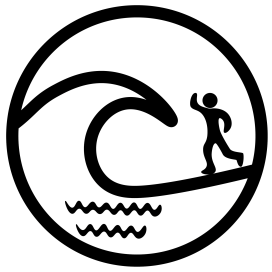Originally presented earlier today at the AGU 2021 Fall Meeting in the “Upgoer Five” Session, this video was inspired by the XKCD comic and book in which scientific concepts are described using only the 1000 most-common words in the English language. I participated in the session last year and had so much fun, I thought I would try it again with my coral reef research.
Unfortunately, ”ocean” and ”sea” were not on the list, so I had to go with ”big blue wet thing” instead. Want to give it a try yourself? Here is a handy tool which checks your writing to see if it meets the list of 1000 most common words: https://splasho.com/upgoer5/ It’s harder than it looks!
Here is a summary of my video:
Some small but beautiful lands in the middle of the big blue wet thing were built by tiny animals that turn into rock when they die. Although these lands might seem perfect and calm most of the time, they are actually in big trouble. The big water is going up and up and up, and the little lands could be completely under it before our kids grow old. However, they are also in trouble right now — waves can hit the little lands and make them go under the water too, even if just for a short while. These waves can hurt people and make the drinking water not-drink-able. It is hard to guess if the waves will cause trouble because they break in different ways than we are used to when they hit the rocks built by animals. The waves become longer and weirder as they move across the rocks, and can hit the land with more power than we would expect. It is even harder to guess what the waves will do because every small land made of rocks built by animals is different, and there are so many of them all around the world. To keep everyone safe, we showed a computer lots of made-up waves so that it could learn how waves look when they hit different sorts of rocks and land. The computer can then make good guesses about what real waves would do if they hit real rocks and land. If the computer thinks that the waves will cause trouble, we can warn people to go somewhere safer until the waves stop. In this way, we hope to keep everyone’s feet dry until long after our kids are old.
You can find more about this stuff in bigger words here:
1. Pearson, S.G., Storlazzi, C.D., van Dongeren, A.R., Tissier, M.F.S., & Reniers, A.J.H.M. (2017). A Bayesian‐based system to assess wave‐driven flooding hazards on coral reef‐lined coasts. Journal of Geophysical Research: Oceans, 122(12), 10099-10117. https://doi.org/10.1002/2017JC013204
2. Pearson, S.G. (2016). Predicting Wave-Induced Flooding on Low-Lying Tropical Islands Using a Bayesian Network. MSc Thesis, Delft University of Technology. http://resolver.tudelft.nl/uuid:c3988f4b-99f8-4936-9504-261b32bb0cd1
3. Roelvink, F.E., Storlazzi, C.D., van Dongeren, A.R., & Pearson, S.G. (2021). Coral reef restorations can be optimized to reduce coastal flooding hazards. Frontiers in Marine Science, 8, 440. https://doi.org/10.3389/fmars.2021.653945
4. Scott, F., Antolinez, J.A., McCall, R., Storlazzi, C.D., Reniers, A.J.H.M., & Pearson, S.G. (2020). Hydro-morphological characterization of coral reefs for wave runup prediction. Frontiers in Marine Science, 7, 361. https://doi.org/10.3389/fmars.2020.00361

